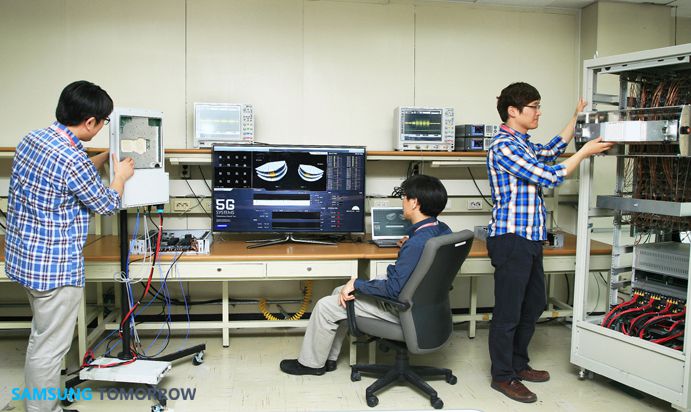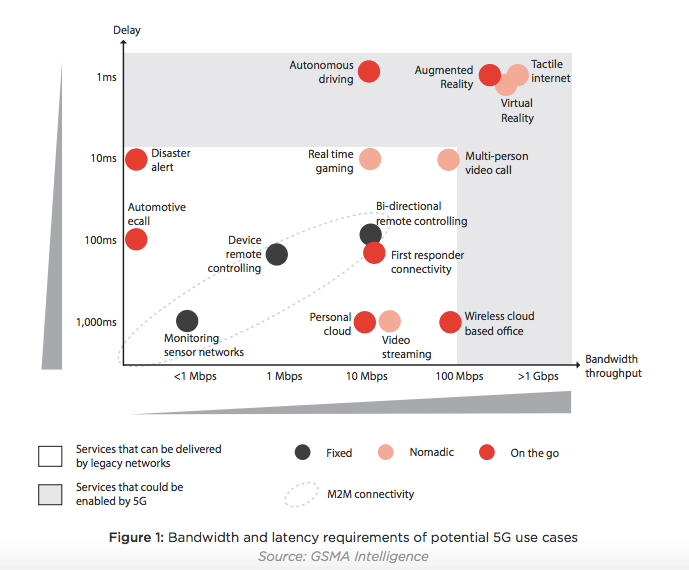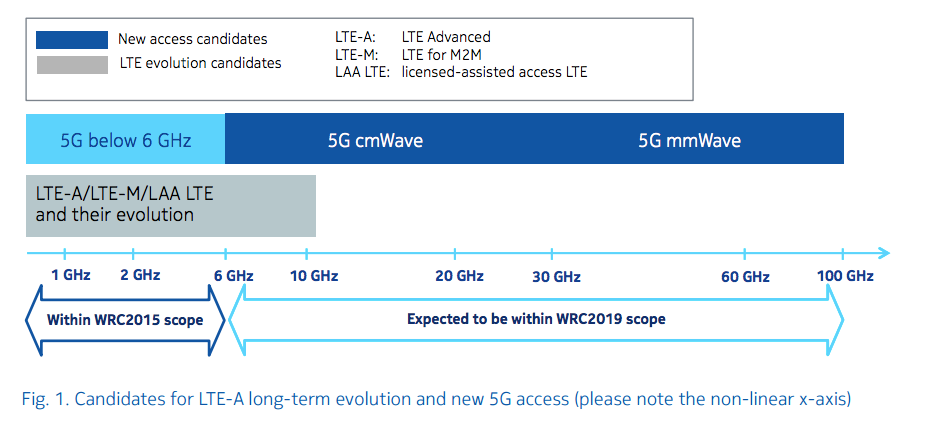5G: What It Is, What It Isn't, And What It Could Be
Anyone who has been following the mobile industry lately has heard the term 5G batted about. Playing off the 3rd and 4th generation mobile technologies that precede it, 5G is intended to be the next evolution in wireless networking standards. We're being promised multi-gigabit connections to the device, latency levels that can support real-time augmented reality sessions in the cloud, and networks that could connect billions of devices in the network of things.
There's only one problem: 5G hasn't been defined yet, and we're likely still years away from seeing an official definition. Today, 5G is more of a concept reflecting the ideas and hopes of global governments, carriers and network equipment makers. What we're witnessing is a process the industry undergoes every decade or so when it tries to come up with the next mobile standard, and as with previous "G"s, that process brings out the best and worst aspects of that industry.

On the one hand, regulators and carriers are trying to hash out what our future mobile needs will be, while the brightest engineers and researchers in the wireless sector and academia are melding minds to find technological answers to those problems.
On the other hand, the marketing machines of networking companies are revving up, making premature and often simplistic pronouncements about what their 5G networks will do. For instance, China's Huawei and Russia's MegaFon have made the ridiculous promise that they will have live 5G networks in time for the 2018 FIFA World Cup.
The mobile industry's largest trade group, the GSM Association, pretty much summed up the problem in a 5G report it issued in December. The report found that there are two competing visions for 5G: one that focuses solely on performance (getting ever-faster speeds out of our mobile connections) and one that focuses on a broader "hyper-connected vision" of connecting billions more people and devices to the mobile network.
That first approach is very enticing, because who doesn't want an insanely fast gigabit connection to their laptop or smartphone? But it's also a very limiting view. There are few applications – and few problems solved – by offering connections with that bandwidth. Building devices and networks capable of supporting those speeds would happen largely in big cities and developed markets. As the GSMA's Senior Director of Technology Dan Warren put it, that version of 5G would give those who already have the most even more.

The other vision for 5G, however, might be overstepping the bounds of what a technical standard can accomplish. Governments and organizations like Facebook's Internet.org are increasingly looking to cellular networks as a means of connecting the unconnected. While creating more flexible networks that deliver cheaper bandwidth to more people can definitely help those efforts along, their underlying goals are political and economic, not technological.
Get Tom's Hardware's best news and in-depth reviews, straight to your inbox.
It's pretty safe to say that the 5G future is still uncertain, but that's not a bad thing. There are serious people tackling serious problems, and when the dust clears, we'll not only have a much better idea of what 5G is from a technical standpoint, but also what the world wants 5G to be. For now though, let's take a look at a few of the key technologies the mobile industry is looking at as 5G contenders.
Massive MIMO
Every new generation of technology brings in new spectrum. In the U.S. we got the 1900 MHz PCS band when we ushered in the 2G digital age, and LTE found its first home in the 700 MHz airwaves, but the available spectrum useful for consumer wireless connectivity is rapidly being used up. 5G researchers are now looking into higher-frequency spectrum in the microwave and millimeter wave bands that have previously been useless for cellular networking.
There's still a lot of debate over the specific frequencies – the proposals range from 6 GHz all the way beyond 100 MHz – but it's clear that there's a lot of potentially untapped spectrum in upper radio bands. We're talking thousands of megahertz compared to the 10 to 20 MHz increments the mobile industry works with today. The problem is that nobody is able to tap those bands for cellular networking because signals transmitting them in don't propagate very far.

Wireless researchers are getting around that problem by using the same multi-antenna technology used by any home Wi-Fi router. Instead of a pair or two of MIMO antennas, millimeter wave networks would use dozens of them, forming massive arrays that could transmit signals much further and achieve speeds up to 100 Gbps.
That's some truly impressive speed, but there are still a lot of questions as to whether massive MIMO is feasible as mobile technology. Not only is the technology complex, but massive antenna arrays require real estate. Device makers are still working out how to shove four 4G antennas into smartphones to support new LTE-Advanced networks. A 5G device might need as many as 128 antennas, along with the power and processing capabilities to decipher their signals.
There are other ways to use that kind of connection. You could connect vehicles, and 5G might wind up replacing the wired broadband connection. But most significantly, massive MIMO could be used to connect other cell sites, according to Shayan Sanyal, Chief Commercial Officer of Bluwan, a networking company researching millimeter wave technologies. The 5G network might actually become a cellular network for connecting 4G networks, replacing the expensive fiber and specialty point-to-point radio links used to backhaul LTE networks today.
"We could use that technology to build very dense networks, helping us solve an age-old problem," Sanyal said.
Cells, Cells Everywhere
Today, cellular networks are built on what's known as a macro scale: big umbrella cells mounted on towers that spread a blanket layer of capacity over a large area. But if we could build dense networks of tightly-packed cells, we would not only see tremendous increases in capacity – every small cell has the same capacity of its macrocell counterpart – but also big gains in speed, as each cell would be splitting its capacity among fewer devices.
Small cells certainly wouldn't be unique to 5G. Carriers like Verizon and AT&T are already deploying them in cities today to meet 4G demands, but new technologies like massive MIMO might help carriers deploy them on an even bigger scale. Instead of laying fiber or carefully provisioning backhaul links, carriers could plop small cells down wherever they chose, and they would automatically connect to the 5G network. The cells would then link to our devices through an optimized version of the LTE connections we know today.
This concept of the super-dense network is being taken up by many of the industry's research labs, and it fits in with another emerging idea known as the "heterogeneous network." The hetnet, as it's called, would be a multi-tiered network made up of multiple layers of transmitters and even multiple wireless technologies. Our devices could not only move seamlessly between those connections but form multiple connections simultaneously.
When we think of 3G and 4G, we think of a single transmission technology. But we may not be able to reduce 5G to single airlink. It might very well wind up being the summation of multiple systems that combine cellular and Wi-Fi, big and small cells, and new technologies like massive MIMO with current technologies like LTE.
Slowing Down The Network
Since its inception, the mobile industry has focused single-mindedly on building faster, brawnier networks to handle the most bandwidth-intensive use on the Internet. But in debate over 5G, a new school of thought is emerging that wants to sacrifice performance in favor of scale.
Instead of architecting networks to support a few HD video streams, we could design them to support thousands of individual low-bandwidth streams that could be delivered at a fraction of the cost and at much lower power than a regular 4G connection.
Building a slower, higher-latency mobile Internet might seem like a step back. But it could also be the means of building a cheaper, more accessible mobile Internet, connecting billions who don't have access to 3G or 4G today or can't afford to use it. It could also be the means of making 5G the backbone network of the Internet of Things, linking billions of sensors and gadgets that only need intermittent access to the network.
It's possible to build a 5G network that blows the barn doors off of today's multi-megabit networks. It's also possible to build a 5G network that can connect every conceivable device and person in the world.
But it's likely impossible to build a network that can do both, according to the GSMA's Warren. That's not necessarily an insurmountable obstacle, though. It could just mean that, unlike previous generations, 5G might well define many different networks, each with different purposes.
That's bound to get confusing since a 5G device could just as easily be a low-end Internet-capable handset or the simplest sensor in addition to being the most sophisticated smartphone produced by Apple or Samsung. That may not be ideal for marketing purposes, but that's not necessarily a bad problem to have. There are bigger issues the mobile industry needs to tackle than merely building the next fastest smartphone.
Follow us @tomshardware, on Facebook and on Google+.
-
uglyduckling81 Let's worry about getting a decent coverage of 4G before thinking about 5G.Reply
I live in the 3rd largest city in Australia and my house is only covered by one company's wireless. Officially I'm in a coverage area for some alternatives but only one provider has a tower in range to make a phone call.
We had a complete monopoly of the phone industry in Australia until about 1999-2000 and it's taking time for things to change. It doesn't help that the government sold all the infrastructure with the company when they privatised the industry. It has lead to extremely anti competitive behaviour from Telstra. Logging a fault with a provider which is leasing from the Telstra network results in very slow tech response. We don't need new technology, we need wide spread current technology from multiple providers. -
Vosgy A lot of Australia's issues are with the very strict regulations, Telstra (and other telcoms) has to lease out it's hardware to all competitors at a greatly reduced price, as a result Telstra and all other phone/internet providers don't want to spend any money on infrastructure as they just have to lease it out to their competitors at a greatly reduced cost. Why spend money so your competitors can get better as well? It is a great example of over regulation, and it makes me understand why there where a lot of Americans that where worried about what the FCC was going to do in their country.Reply -
NightshadeRC There is a flip side to the 4g in Australia, when you do get it it's a hell of a lot quicker than what you guys get in the US. 4g on my phone nets me 40-60Mbps.Reply
The funny part is that some of the cheap plans still have 200MB monthly limits. 30 seconds and your out for the month. -
mrmez I thought Telstra only had to sell it's land lines, not mobile spectrum.Reply
Optus sell their mobile spectrum tho.
Either way, I've got ~100Mb/s down on 4G, so unless 5G makes more efficient use of the spectrum.... how will 5G be better? -
Vosgy Reply15590149 said:I thought Telstra only had to sell it's land lines, not mobile spectrum.
Optus sell their mobile spectrum tho.
Either way, I've got ~100Mb/s down on 4G, so unless 5G makes more efficient use of the spectrum.... how will 5G be better?
The mobile networks are regulated much less and there is much more competition in the mobile market in Australia. This can be best seen with you getting 100ish Mb/s on 4G, where the average fixed line home internet in Australia is 4Mb/s. The problem with the fixed network is it was all owned by the government when it was a nation asset, when Telstra was sold Mobile was no where near as big and the infrastructure owned by Telstra was much smaller, allowing for others to break into the field. The heavy regulation on fixed infrastructure was to allow others into the market, it has prevented any real development of the infrastructure for around the past 15 years (to the point where the government has to intervene). If Telstra (or any other provider) was the only Mobile provider in an area they have to allow leasing to allow people choice, even if it isn't real choice. Assuming Another company even wants to lease it with all the bother that can cause. -
PaulBags %90 of the reason I own a smartphone is something to do on the bus commute. I see major roads where the network drops out, spotty page loads that require constant refreshing until they work, 3g that's lightening fast, 4g that can't load facebook; and I'll even drop to EDGE in a 4g zone a handful of times a month.Reply
To me this implies a low density of towers, some struggling already with capacity or connecting at 4g when they're actually too far/weak to be effective. And/or poor tower hand offs at 50kph. And/or poor backhaul. And/or routing issues (facebook being particularly bad even while other sites load snappy).
I hope 5g can address some issues, to be easier & cheaper for carrier to impliment so that unlike 4g they actually do it right & build networks that actually work. -
Jalapenoman If they were able to keep the latency and bandwidth similar to 4G, then they could use the new tech to expand coverage. Everything in life has tradeoffs, they just have to find the right balance.Reply -
Derek Bartron ReplySo how do i fix my lap top
Bake at 350 for 20 minutes then immediately submerge it in ice water to reseat the processor.